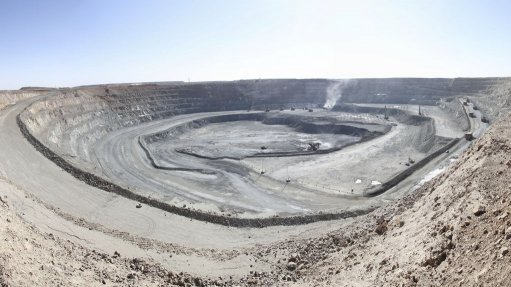On-The-Air (10/03/2017)
Every Friday morning, SAfm’s AMLive’s radio anchor Sakina Kamwendo speaks to Martin Creamer, publishing editor of Engineering News and Mining Weekly. Reported here is this Friday’s At the Coalface transcript:
Kamwendo: The strong outlook for South Africa’s ferrochrome industry is a great plus for South Africa in its hour of need.
Creamer: It is fantastic that ferrochrome is coming back. It went down badly just over a year ago, but you can see the recovery is much firmer now. We are big producers of ferrochrome and we do it very competitively and very cleanly. We have got that chrome in the ground and the big benefit of this is that we uplift that value of that chrome to make it ferrochrome.
So, we are not just sending out the raw ore, in this case ferrochrome, we are adding that value –sometimes a five times uplift. To see the outlook now looking strong is very firm for us. The price is going for at least the next quarter at a high level, which means that there is demand. We look at the use of ferrochrome, it goes into stainless steel and the outlook and demand for stainless steel and production of stainless steel in China is looking good both in 2017 and 2018 above the 3% level. That all goes well for us.
This has been a fantastic industry for us, but it was knocked back a bit because of the electricity supply. One of the producers the Glencore Merafe Chrome Venture, they did a very slick thing. They brought in a very low-energy low-electricity use system called Premus technology.
That has really allowed it to do very well even in times of low-electricity supply. Fortunately, the news coming out of Merafe now, which reported very good record results this week, they were saying that there is no longer this restraint from electricity. We find now, because of the low growth of the South African economy, that electricity is now available, which is also a plus for the ferrochrome industry.
There is another aspect to this, which is chrome, of course. You can see that what they don’t use for ferrochrome, when they have got surplus chrome, they export that as well. South Africa is by far the biggest exporter of chrome into China. So, we are also exporting unbeneficiated ore into China, 73% of Chinas imports came from South Africa. Hopefully this industry will be able to recover.
We saw just over a year ago several of the companies had to exit and the overall production from South Africa is down, whereas you see Kazakhstan and other countries production going up. It is always a competitive market throughout the world. At least we are on firmer footing and we are doing it in a way that is cleaner than a lot of people are doing around the world, which should be a plus for us on the climate change ranking.
Kamwendo: As the rand strengthens, it is becoming increasingly apparent that new, cheaper mining methods are desperately needed to save the industry.
Creamer: We shouldn’t be so reliant on a weak rand in the mining industry. We saw ashen faced CEOs the moment that rand fell into the R12 range. They were suddenly thinking of cutting back. Comments were that were going to have to cut back on capex, because South Africa has become reliant on the weak rand and we shouldn’t be that reliant on it. We have got to take a leap forward.
The only way that we can do that is to introduce new cheaper mining methods. The talk around town is that this is going to happen. We even saw the Department of Trade and Industry (DTI) Minister Rob Davies is complimenting the fact that we are moving forward now with new equipment. The DTI is funding this new equipment development and we see it happening in Joburg at the Comro site, which is the old Chamber of Mines Research Organisation.
We know that it went through its ups and downs, because in the mid-nineties it was handed over to the government and then the CSIR didn’t do a good job of it. It has now come back and is really an informal public-private partnership with both the Chamber of Mines and the government chipping in there to do something. We see movement and we saw a pleasing response from the Minister to some of the effort that he is doing to make sure that mining equipment is developed here for our deep-level mining.
Of the ten deepest mines in the world, eight are out gold mines in South Africa, but there is still a lot of gold there. We are talking about something like 400-million tonnes of gold ore in the ground that is amenable to mining through mechanised methods.
Another 160-million tonnes of ore in the pillars that is amenable through mechanised mining. If you don’t bring in this modernisation and mechanisation, we see an end beginning as early as 2020 and then going stone dead in 2033. So, something has to happen, we can see there is an incentive to do it, we know the gold is there. If you calculate in ounces they are talking about 1.3-billion ounces of gold still in the ground. Are we going to leave that behind? It is the same story with the platinum, if we get the mechanised methods it is going to be a longevity for it.
The wonderful thing for it is that the South Africans are saying the mechanisation will be people centric, people will be at the centre of this. We don’t want huge job losses and want to absorb the people at higher level into the new skills position up train and keep it people centric. In South Africa we have got to do that and when we look at our number of people now compared to Canada we have lost so many jobs already.
We are talking about an equivalent of 550 000 people employed, whereas Canada employs the same number at a much higher level. We need to do that in South Africa as well.
Kamwendo: West African mining is setting a good example by using the sun to power its mines.
Creamer: Mines is all about paydirt, so you think of dirt with mines, but a lot of the mines want to be clean now. It is not just because they want to be clean, it is for economic reasons and we see in the Western Africa mining setting, gold miners there are always complaining that they have got to bring in diesel and the logistics are hectic and the costs goes up and down.
Of course, it is down now, but it will probably go up at some stage. You see that the company Iamgold listed in Toronto and New York has got the Essakani mine in which the West African governments also have a share. It has been decided that they are going to go for sun energy. They have got a lot of land and can put up the photovoltaics.
There are companies that come in, it is not as if the mine has to outlay any money. All the mines has to do is sign on the dotted line. These people come in and put in all the photovoltaic, it does require a lot of land, so you do need land from the mine, but then they set up a system and they give you the mega wattages of electricity you need and you can earn credits on it. It is now carbon emission free and people are seeing this as the way to go.
Even though mining is a dirty industry they are looking to clean it up, but for economic reasons and using the sun. We know that even out at Carletonville, Sibanye is considering putting up a big sun energy plant to get their energy from the sun. Because, as things stand now, we see that they can do it competitively. They can beat Eskom at their own game even though they don't have to outlay too much. There are specialists that come in and put the infrastructure down and all you have to say is we will take this power over a long period of time.
Kamwendo: Thanks very much. Martin Creamer is publishing editor of Engineering News and Mining Weekly.
Comments
Press Office
Announcements
What's On
Subscribe to improve your user experience...
Option 1 (equivalent of R125 a month):
Receive a weekly copy of Creamer Media's Engineering News & Mining Weekly magazine
(print copy for those in South Africa and e-magazine for those outside of South Africa)
Receive daily email newsletters
Access to full search results
Access archive of magazine back copies
Access to Projects in Progress
Access to ONE Research Report of your choice in PDF format
Option 2 (equivalent of R375 a month):
All benefits from Option 1
PLUS
Access to Creamer Media's Research Channel Africa for ALL Research Reports, in PDF format, on various industrial and mining sectors
including Electricity; Water; Energy Transition; Hydrogen; Roads, Rail and Ports; Coal; Gold; Platinum; Battery Metals; etc.
Already a subscriber?
Forgotten your password?
Receive weekly copy of Creamer Media's Engineering News & Mining Weekly magazine (print copy for those in South Africa and e-magazine for those outside of South Africa)
➕
Recieve daily email newsletters
➕
Access to full search results
➕
Access archive of magazine back copies
➕
Access to Projects in Progress
➕
Access to ONE Research Report of your choice in PDF format
RESEARCH CHANNEL AFRICA
R4500 (equivalent of R375 a month)
SUBSCRIBEAll benefits from Option 1
➕
Access to Creamer Media's Research Channel Africa for ALL Research Reports on various industrial and mining sectors, in PDF format, including on:
Electricity
➕
Water
➕
Energy Transition
➕
Hydrogen
➕
Roads, Rail and Ports
➕
Coal
➕
Gold
➕
Platinum
➕
Battery Metals
➕
etc.
Receive all benefits from Option 1 or Option 2 delivered to numerous people at your company
➕
Multiple User names and Passwords for simultaneous log-ins
➕
Intranet integration access to all in your organisation




















